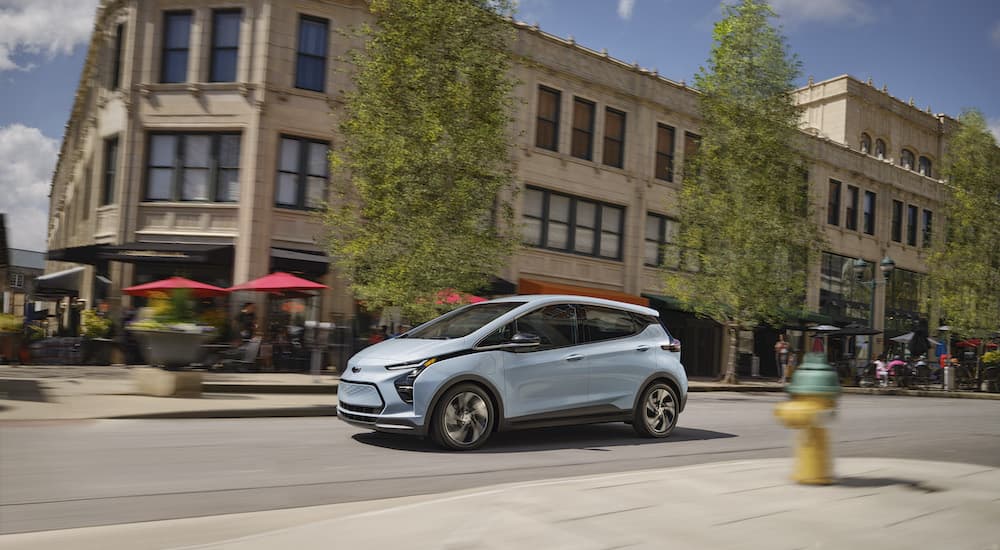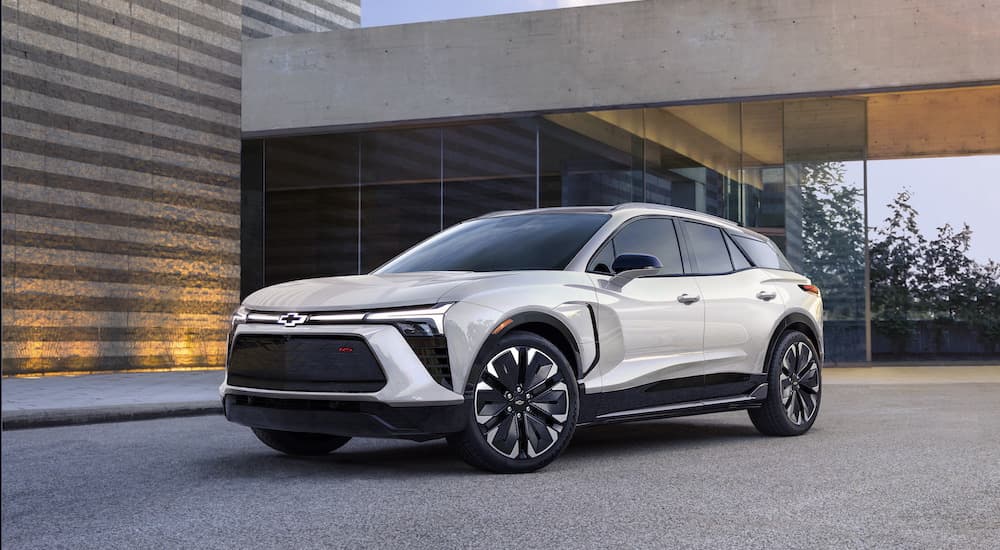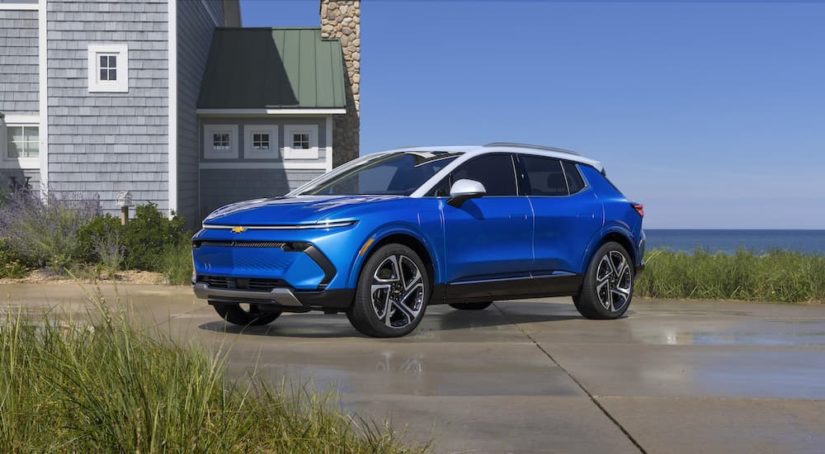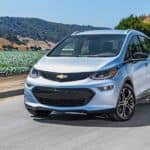Electric vehicles (EVs) are seen as the future of the automotive industry. As resources become scarce and gas prices rise, there is a need to find alternative ways to propel our vehicles. In addition, many folks are concerned about the pollution produced by internal combustion engines running on gasoline and diesel fuel. As a result, EVs have moved to the front of alternative energy vehicles. If you go into the Chevrolet dealer near you, you will soon see the future of the EV and the bowtie brand.
Chevrolet has positioned itself as a leader in EVs. Starting with the Volt in 2007, the first commercially successful plug-in hybrid model, Chevy has shown that electrification can be a valuable way to reduce our reliance on fossil fuels. Chevy has also demonstrated that EVs don’t have to be limited to those wealthy enough to afford luxury vehicles like those produced by Tesla. The Bolt EV and Bolt EUV are two of the most affordable EVs on the market today. This has allowed family drivers and commuters on a budget to take advantage of the benefits of going electric. For Chevrolet, the next step starts with its use of the Ultium platform.

Ultium Leads the Way for Chevy
Chevy’s parent company, GM, has bet big on the future of EVs. Big, in this case, means $35 billion through 2025. This represents a 75% increase over what was initially announced by GM in 2020. As GM Chair and CEO Mary Barra points out, “We are investing aggressively in a comprehensive and highly-integrated plan to make sure that GM leads in all aspects of the transformation to a more sustainable future.” This is where its commitment to Ultium comes in.
Ultium is GM’s battery cell engineering and EV platform. The technology involves using a series of lithium pouch cells placed in a skateboard pack in the floor of the vehicle, which provides a number of benefits. First, it helps shield the battery cells from damage, as the frame is often the strongest part of the vehicle. Second, it allows for flexibility, as cells can be added, removed, or even upgraded as needed. This can enhance performance and make repairs easier than ever.
The goal of Ultium is to leverage the economies of scale made possible by GM’s position as the largest automaker in the United States. GM is already constructing Ultium battery manufacturing plants in Ohio, Tennessee, and Michigan and has recently announced that work will soon begin on a fourth plant. This will help ensure that there are no supply chain disruptions in the production and delivery of battery cells for its new lineup of EVs.
Given that Chevrolet is by far the largest of GM’s four American brands, it is not surprising that Chevy was chosen to be the backbone of GM’s move into EVs. Chevrolet has always been at the forefront of producing affordable vehicles that are dependable and perform well under different circumstances. This has certainly been the case with its comprehensive lineup of SUVs. No other automaker offers as many different sizes and styles of SUVs as Chevy.
A New Approach to the Electric SUV
Up to this point, most established automakers that produce an EV have chosen to design a new model specifically designed for that purpose. For example, the Chevy Bolt EV was designed to be an EV from the ground up. However, Chevy decided to do something new with its upcoming vehicles and electrify existing models.
This is similar to the evolution of hybrid vehicles. When hybrids first hit the road, automakers built new models to house this alternative energy engine. Probably the most famous hybrid is the Toyota Prius, which was a radical design purpose-built for hybrid technology. Chevy’s Volt followed a similar pattern. However, over time, automakers began to put hybrid engine options into existing models. For example, Chevy used its popular Malibu midsize sedan as a platform for a hybrid powertrain in 2008.
Chevy plans to take a similar approach with EVs for its upcoming 2024 models. The plan is to begin offering some of Chevy’s most popular SUVs with an EV option. The first two slated for this new project are the midsize Chevy Blazer and the compact Chevy Equinox. It shouldn’t come as a surprise to see Chevy choosing the Blazer and Equinox for the first EV SUVs in its growing lineup. These are two of Chevy’s most popular models, with the Blazer providing sporty styling and the Equinox delivering a roomy crossover that is compact in name only.
Scott Bell, vice president of Chevrolet, points out that “Chevrolet is now positioned to offer a wide array of EVs. We know truck and SUV customers better than anyone, and we’ve channeled that insight and experience into our new EVs.” The choice of the Blazer and Equinox demonstrates Chevy’s market knowledge and will give drivers the option of all-electric performance in a model they know and love.
2024 Blazer EV
The 2024 Chevy Blazer EV will give folks a powerful electric motor that should deliver serious performance. In its top trim, it will have an estimated 557 hp and 648 lb-ft of torque. As Phil Zak, the executive director of Chevrolet Design, explains, “The Blazer EV’s design evokes the same sort of emotional response as Chevy’s performance vehicles.” With an estimated range of up to 320 miles, the Blazer EV should be a great choice for folks looking to go out on a road trip who don’t want to get stuck with high gas prices. Chevy includes advanced DC fast-charging in the Blazer EV, making it capable of adding 78 miles of range in as little as 10 minutes.
One of the most distinctive features of the 2024 Blazer EV is its massive 17.7-inch touchscreen for the customizable infotainment system. This is one of the largest touchscreens available on any SUV, and it will come standard on all models of the 2024 Blazer EV. If that is not enough screen for you, don’t panic––the Blazer EV pairs it with an 11-inch driver display. This model comes with standard front-wheel, but rear-wheel drive and all-wheel drive are available, demonstrating the flexibility and modularity of the Ultium platform.

2024 Equinox EV
Where the Blazer EV is designed for performance, the Equinox EV is built for convenience. This is an exceptional model for the economical commuter or family driver. The 2024 Equinox EV comes with front-wheel drive standard and is available with all-wheel drive. There are also two different battery options for the 2024 Equinox EV. One will have an estimated range of 250 miles with front-wheel drive only, while the other will have an extended range of 300 miles with front-wheel drive or 280 miles with all-wheel drive. This should be more than enough to get you through your daily commute. Whichever powertrain you choose, you will be able to recharge 70 miles of range in 10 minutes at a DC fast-charging station.
The goal with the Equinox EV is to provide a vehicle that is affordable for all income levels, with versatility that makes it perfect for commuters, families, and first-time drivers. With up to 57 cu.ft. of cargo space, the Equinox EV is also very capable. This is the kind of trunk space you would expect in larger vehicles and helps make the Equinox EV ideal for so many different drivers. As Scott Bell notes, “The Equinox EV is an EV for everyone. It’s an affordable game-changer, offering an uncompromising experience, with more features, that won’t change your daily routine––except that you will no longer have to stop at the gas station.”
Chevy’s Future Is Electric
GM has made a major wager on the EV market. This is shown by its investment in Ultium and the building of four new battery manufacturing plants. It is also evidenced by its dedication to building more EVs, with a focus on offering an all-electric option for many popular models from Chevrolet. This is starting with the 2024 Chevy Blazer EV and the 2024 Chevy Equinox EV. However, it doesn’t look like it will end there, so we should expect to see more Chevy SUV models turning into EVs in the future. As the song goes, Chevy’s future’s so bright it’s gotta wear shades.



